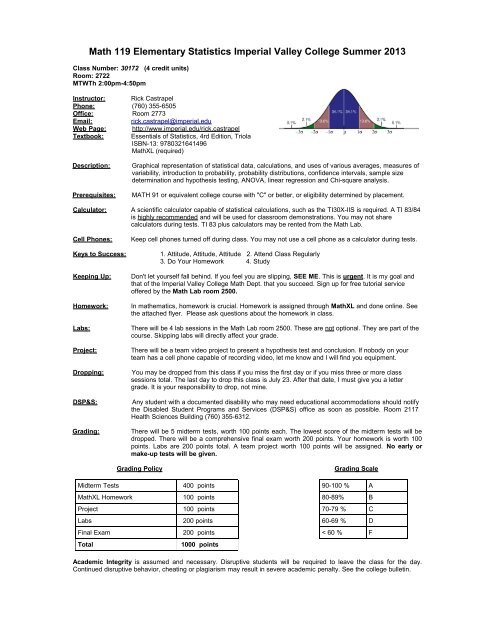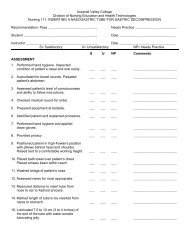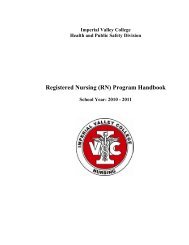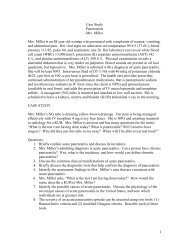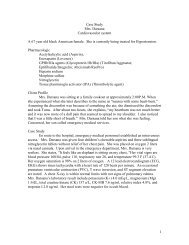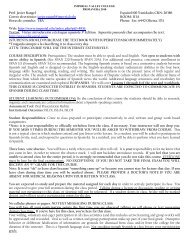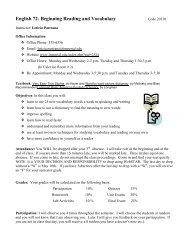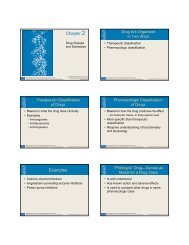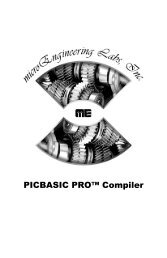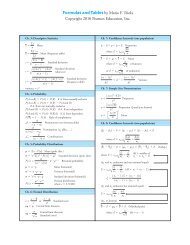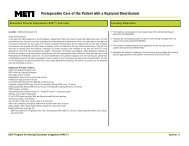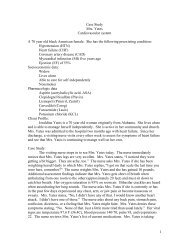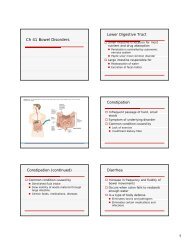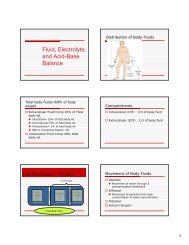Math 119 Elementary Statistics Imperial Valley College Summer 2013
Math 119 Elementary Statistics Imperial Valley College Summer 2013
Math 119 Elementary Statistics Imperial Valley College Summer 2013
You also want an ePaper? Increase the reach of your titles
YUMPU automatically turns print PDFs into web optimized ePapers that Google loves.
<strong>Math</strong> <strong>119</strong> <strong>Elementary</strong> <strong>Statistics</strong> <strong>Imperial</strong> <strong>Valley</strong> <strong>College</strong> <strong>Summer</strong> <strong>2013</strong><br />
Class Number: 30172 (4 credit units)<br />
Room: 2722<br />
MTWTh 2:00pm-4:50pm<br />
Instructor: Rick Castrapel<br />
Phone: (760) 355-6505<br />
Office: Room 2773<br />
Email:<br />
rick.castrapel@imperial.edu<br />
Web Page: http://www.imperial.edu/rick.castrapel<br />
Textbook: Essentials of <strong>Statistics</strong>, 4rd Edition, Triola<br />
ISBN-13: 9780321641496<br />
<strong>Math</strong>XL (required)<br />
Description:<br />
Prerequisites:<br />
Graphical representation of statistical data, calculations, and uses of various averages, measures of<br />
variability, introduction to probability, probability distributions, confidence intervals, sample size<br />
determination and hypothesis testing, ANOVA, linear regression and Chi-square analysis.<br />
MATH 91 or equivalent college course with "C" or better, or eligibility determined by placement.<br />
Calculator: A scientific calculator capable of statistical calculations, such as the TI30X-IIS is required. A TI 83/84<br />
is highly recommended and will be used for classroom demonstrations. You may not share<br />
calculators during tests. TI 83 plus calculators may be rented from the <strong>Math</strong> Lab.<br />
Cell Phones:<br />
Keys to Success:<br />
Keeping Up:<br />
Homework:<br />
Labs:<br />
Project:<br />
Dropping:<br />
DSP&S:<br />
Grading:<br />
Keep cell phones turned off during class. You may not use a cell phone as a calculator during tests.<br />
1. Attitude, Attitude, Attitude 2. Attend Class Regularly<br />
3. Do Your Homework 4. Study<br />
Don't let yourself fall behind. If you feel you are slipping, SEE ME. This is urgent. It is my goal and<br />
that of the <strong>Imperial</strong> <strong>Valley</strong> <strong>College</strong> <strong>Math</strong> Dept. that you succeed. Sign up for free tutorial service<br />
offered by the <strong>Math</strong> Lab room 2500.<br />
In mathematics, homework is crucial. Homework is assigned through <strong>Math</strong>XL and done online. See<br />
the attached flyer. Please ask questions about the homework in class.<br />
There will be 4 lab sessions in the <strong>Math</strong> Lab room 2500. These are not optional. They are part of the<br />
course. Skipping labs will directly affect your grade.<br />
There will be a team video project to present a hypothesis test and conclusion. If nobody on your<br />
team has a cell phone capable of recording video, let me know and I will find you equipment.<br />
You may be dropped from this class if you miss the first day or if you miss three or more class<br />
sessions total. The last day to drop this class is July 23. After that date, I must give you a letter<br />
grade. It is your responsibility to drop, not mine.<br />
Any student with a documented disability who may need educational accommodations should notify<br />
the Disabled Student Programs and Services (DSP&S) office as soon as possible. Room 2117<br />
Health Sciences Building (760) 355-6312.<br />
There will be 5 midterm tests, worth 100 points each. The lowest score of the midterm tests will be<br />
dropped. There will be a comprehensive final exam worth 200 points. Your homework is worth 100<br />
points. Labs are 200 points total. A team project worth 100 points will be assigned. No early or<br />
make-up tests will be given.<br />
Grading Policy Grading Scale<br />
Midterm Tests 400 points 90-100 % A<br />
<strong>Math</strong>XL Homework 100 points 80-89% B<br />
Project 100 points 70-79 % C<br />
Labs 200 points 60-69 % D<br />
Final Exam 200 points < 60 % F<br />
Total 1000 points<br />
Academic Integrity is assumed and necessary. Disruptive students will be required to leave the class for the day.<br />
Continued disruptive behavior, cheating or plagiarism may result in severe academic penalty. See the college bulletin.
<strong>Math</strong> <strong>119</strong> <strong>Summer</strong> <strong>2013</strong> Tentative Schedule<br />
Date Text Event Notes<br />
06/24/13 1-2,1-3,1-4,1-5 Introduction to <strong>Statistics</strong><br />
06/25/13 2-2, 2-3,2-4,2-5 Summarizing and Graphing Data<br />
06/26/13 3-2,3-3,3-4 <strong>Statistics</strong> for Describing Data<br />
06/27/13 Lab Rm 2500 Measures<br />
07/01/13<br />
07/02/13 4-3, 4-4 Craps Addition Rule, Basic Multiplication Rule, Examples: Craps<br />
07/03/13 4-5,4-6,5-2 Mult. Rule, Counting, Random Variables<br />
07/04/13 Holiday Independence Day<br />
07/08/13 Lab Rm 2500 Discrete Probability Distributions<br />
07/09/13 5-3, 5-4 Binomial Distribution, Poisson Distribution<br />
07/10/13<br />
4-1, 4-2<br />
6-2, 6-3<br />
Test 1 Chapters 1, 2 and 3<br />
Basic Concepts of Probability<br />
Test 2 Chapters 4 and 5<br />
Introduction to Normal Distribution<br />
07/11/13 6-4,6-5,6-6 Normal Distribution<br />
07/15/13 Lab Rm 2500 Normal Distribution<br />
07/16/13 7-1, 7-2, 7-3<br />
Estimates of proportions, means with σ known<br />
07/17/13 7-4, 7-5<br />
07/18/13<br />
07/22/13 8-3,8-4,8-5,8-6 Hypothesis Testing<br />
07/23/13 Lab Rm 2500 Hypothesis Testing<br />
07/24/13<br />
07/25/13 9-3, 9-4 Inferences about two means, indep. and dep.<br />
07/29/13 10-1, 10-2, 10.3 Linear Correlation and Regression<br />
07/30/13 11-3,11-4(12-2) Contingency Tables, ANOVA<br />
07/31/13<br />
8-1, 8-2<br />
9-1, 9-2<br />
Test 3<br />
Projects<br />
Assigned<br />
Estimates of means with σ unknown, variances<br />
Chapters 6 and 7<br />
Basics of hypothesis testing<br />
Test 4 Chapter 8<br />
Inferences about two proportions<br />
Test 5<br />
Project<br />
Reports<br />
Chapters 9, 10-2, 10-3, 11-3, 11-4<br />
08/01/13 Final Exam Comprehensive Final
First Day of Class<br />
http://www.mathxl.com/Instructor/FirstDayHandout.ashx?cId=2074554&...<br />
1 of 1 6/3/<strong>2013</strong> 11:24 AM<br />
How to Register and Enroll in Your Course<br />
Welcome to <strong>Math</strong>XL! Your instructor has set up a <strong>Math</strong>XL course for you.<br />
The course name is: <strong>Math</strong> <strong>119</strong> <strong>Statistics</strong> Su'13 2:00pm 30172<br />
It is based on this textbook: Triola: <strong>Elementary</strong> <strong>Statistics</strong>, 10e<br />
To join this course, you need to register for <strong>Math</strong>XL and then enroll in the course.<br />
1. Registering for <strong>Math</strong>XL<br />
Before you begin, make sure you have the access code that comes with your <strong>Math</strong>XL Access Kit.<br />
To register or buy access, go to www.mathxl.com, click the Student button in the Register section, and then follow the instructions on<br />
the screen.<br />
2. Enrolling in your instructor's course<br />
After registering, log in to <strong>Math</strong>XL with your username and password. To enroll in this course, enter the following Course ID:<br />
The Course ID for your course is: XL18‐G1QI‐301Y‐23Y2<br />
Need more help?<br />
To view a complete set of instructions on registering and enrolling, go to www.mathxl.com and visit the Tours page.
STUDENT LEARNING OUTCOMES: Upon course completion, the successful student will have<br />
acquired new skills, knowledge, and or attitudes as demonstrated by being able to:<br />
• Identify, compare, and contrast two articles that include both descriptive and inferential<br />
statistics on the same research topic. (ILO2, ILO4)<br />
• Apply their knowledge of statistical inference to conduct formal significance tests<br />
concerning single populations. (ILO2)<br />
• Demonstrate their knowledge of basic descriptive statistics. (ILO2, ILO4)<br />
• Apply techniques of linear modeling to explore the relationship between two numerical<br />
variables. (ILO2)<br />
MEASURABLE COURSE OBJECTIVES AND MINIMUM STANDARDS FOR GRADE OF "C":<br />
Upon satisfactory completion of the course, students will be able to:<br />
1. Distinguish the various ways of organizing, displaying, and measuring data.<br />
2. Derive the numerical relationship that exists between bivariate data sets.<br />
3. Demonstrate an understanding of the theory of probability and proficiency in solving problems<br />
of this nature.<br />
4. Compute and interpret expected values and variance, and learn about the binomial distribution<br />
for discrete random variables.<br />
5. Compute and interpret expected values and variance, and learn about the normal distribution<br />
or continuous random variables.<br />
6. Examine the joint probability structure of two or more random variables and understand the<br />
limiting behavior of the sum of independent random variables as the number of the sample<br />
becomes larger.<br />
7. Use the various types of distributions that are derived from the normal distribution.<br />
8. Calculate and interpret confidence intervals for a population mean to show how probability<br />
connects to this type of statistical inference.<br />
9. Use hypothesis testing as a formal means of distinguishing between probability distributions<br />
on the basis of random variables generated from one of the distributions.<br />
10. Compare the means of the data from experiments involving more than two samples,<br />
including the single factor analysis of variance (ANOVA).<br />
11. Fit a straight line to the given data in graphical form.<br />
12. Make use of Chi-square distributions to analyze counts.


